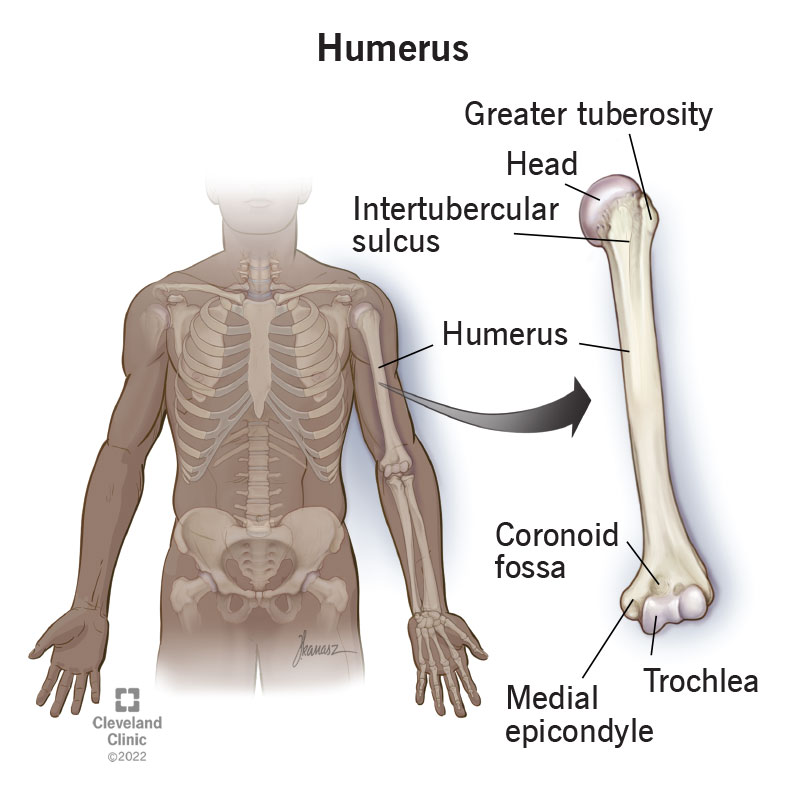The humerus is your upper arm bone. It’s connected to 13 muscles and helps you move your arm. When you injure your humerus, it’s likely the muscles and nerves attached to it will be damaged, too. If your bones are weakened by osteoporosis, you have an increased risk for fractures you might not even know about.

The humerus is your upper arm bone. Other than the bones in your leg, it’s the longest bone in your body. It’s a critical part of your ability to move your arm. Your humerus also supports lots of important muscles, tendons, ligaments and parts of your circulatory system.
If you experience a fractured (broken) humerus, you might need surgery to repair your bone and physical therapy to help you regain your strength and ability to move.
Your humerus — like all bones — can be affected by osteoporosis.
Because your humerus is connected to so many muscles and nerves, injuries to one can often affect the others.
Cleveland Clinic is a non-profit academic medical center. Advertising on our site helps support our mission. We do not endorse non-Cleveland Clinic products or services. Policy
Your humerus has several important jobs, including:
The humerus is the only bone in your upper arm. It runs from your shoulder to your elbow.
The humerus has a rounded end where it meets your shoulder, a long shaft in the middle and a flatter end that forms your elbow joint. The upper end has a ball shape that fits into your shoulder socket.
Even though it’s one long bone, your humerus is made up of several parts. These include:
The upper (proximal) end of your humerus connects to your shoulder joint. The proximal end (aspect) contains the:
The shaft is the long middle portion of the humerus that supports the weight of your upper arm and gives it its shape. It’s slightly rounded at the top near your shoulder and flatter at the bottom near your elbow. The shaft of your humerus includes the:
The lower (distal) end of your humerus forms the top of your elbow joint. It meets your forearm bones (radius and ulna). It includes the:
All these parts and labels are usually more for your healthcare provider to use as they describe where you’re having pain or issues. If you ever break your humerus — a humeral fracture — your provider might use some of these terms to describe where your bone was damaged.
Other than the bones in your legs, your humerus is the largest bone in your body. Most adults’ humerus bones are around a foot long.
The most common issues that affect the humerus are fractures, osteoporosis and damage to nerves or muscles attached to it.
A bone fracture is the medical term for breaking a bone. You can break your humerus during trauma, like a fall or car accident. Some people also experience humerus fractures playing sports. Symptoms of a fracture include:
Go to the emergency room right away if you’ve experienced trauma or think you have a fracture.
Osteoporosis weakens bones, making them more susceptible to sudden and unexpected fractures. Many people don’t know they have osteoporosis until after it causes them to break a bone. There usually aren’t obvious symptoms.
Women or people assigned female at birth (AFAB) and adults older than 50 have an increased risk for developing osteoporosis. Talk to your provider about a bone density test that can catch osteoporosis before it causes a fracture.
When you injure your humerus, it’s likely the muscles and nerves attached to it will be damaged, too. Some of the most common nerve and muscle damage includes:
Talk to your provider if you’re experiencing new pain in your arm or shoulder.
The most common test done to check the health of your humerus is a bone density test. It’s sometimes called a DEXA or DXA scan. A bone density test measures how strong your bones are with low levels of X-rays. It’s a way to measure bone loss as you age.
If you’ve experienced a humeral fracture, your provider or surgeon might need imaging tests, including:
Usually, your humerus won’t need treatment unless you’ve experienced a fracture or other injury to your arm. You might need treatment if you’ve been diagnosed with osteoporosis.
How your fracture is treated depends on what caused it and where the break is in your humerus. You’ll need some form of immobilization — like a splint or cast — and might need surgery to realign (set) your bone to its correct position and secure it in place so it can heal.
Treatments for osteoporosis can include vitamin and mineral supplements, exercise and medications.
Exercise and taking supplements are usually all you’ll need to prevent osteoporosis. Your provider will help you develop a treatment plan that’s customized for you and your bone health.
A healthcare provider will diagnose and treat shoulder dislocations and rotator cuff injuries. Most people who experience a shoulder dislocation need to wear a sling for a few weeks. You’ll need surgery to repair a torn rotator cuff.
Following a good diet and exercise plan and seeing your healthcare provider for regular checkups will help you maintain your bone (and overall) health. If you’re older than 50 or have a family history of osteoporosis, talk to you provider about a bone density scan.
Follow these general safety tips to reduce your risk of an injury:
A note from Cleveland Clinic
Your humerus is an important bone that lets you use your arms the way you do every day. Talk to your provider about your osteoporosis risk. Anything you do to improve your overall health will also help keep your bones strong.
Last reviewed by a Cleveland Clinic medical professional on 01/03/2023.
Learn more about our editorial process.
Cleveland Clinic is a non-profit academic medical center. Advertising on our site helps support our mission. We do not endorse non-Cleveland Clinic products or services. Policy